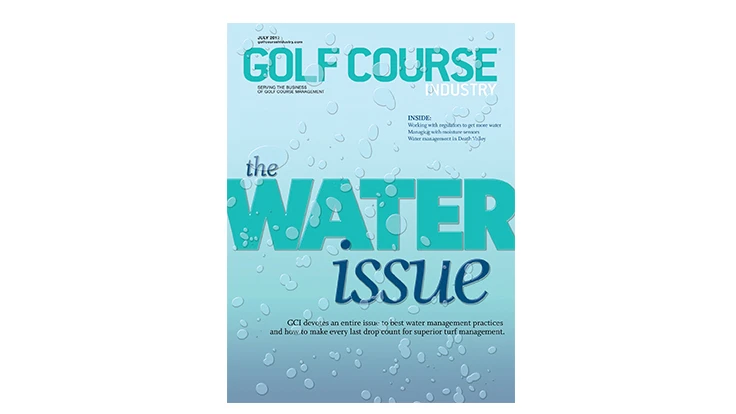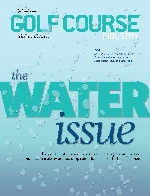
 There remains no simple way or shortcut to arrive at a method to manage irrigation water, especially given the inherent inefficiencies of a water application with a circular pattern with designed overlaps along with single-head coverage.
There remains no simple way or shortcut to arrive at a method to manage irrigation water, especially given the inherent inefficiencies of a water application with a circular pattern with designed overlaps along with single-head coverage.
However, the increase use of handheld moisture meters and in-ground moisture sensors have brought about many changes in water management and hand-water applications particularly on greens surfaces. The superintendent must quantify the use of the current irrigation system by adjustments individual heads on a constant basis, which remains our best practice today. Without the baseline numbers from an audit, it remains a guessing game on what areas of the course are receiving quality coverage. Out of all information attained from irrigation audits, the most important number to attain remains Distribution Uniformity (DU); that percentage is the broad report card of the irrigation systems ability to apply water evenly over a given area.
When a superintendent designs a schedule for water distribution, that schedule must be modified to accommodate changes in weather or evapotranspiration (ET) which can change the turfs need for water. An audit provides the tools necessary to meet these requirements.
Our modern irrigation systems become less efficient with time and even the most advanced systems were never designed or intended to be a “set-it-and-forget-it” water distribution tool. The recommended schedule resulting from an audit is based on the field results; inspections, distribution uniformity, precipitation rate, soil intake amounts, turf water use, root zone depth and soil water holding capacity. Further adjustments to scheduling must be made to accommodate the limits of the control system used to operate the system.
Audit Worksheets
These worksheets use data accumulated from a proper and complete Irrigation Audit to quantify cost savings and operational efficiencies. Editor’s Note: These worksheets are based on information from Irrigation Association, Certified Golf Irrigation Auditor Manual, July, 2004.

An added benefit to an irrigation audit, or multiple audits, is to identify trends in irrigation system maintenance or other system needs. Typical irrigation maintenance activities that may be identified by an audit include:
- Adjusting and leveling sprinkler heads
- Adjusting arcs for proper pattern coverage
- Ensuring there is nozzle and sprinkler uniformity
- Clearing clogged nozzles;
- Replacing drive mechanisms or irregular rotating heads. Also, an audit may alert superintendents to more significant problems, such as:
- Moving heads to more appropriate spacing
- Adjusting pressures at pumping source
- Adding pressure regulating devises
- Component upgrades – sprinklers, valves, pressure regulating valves, screens, filters).
Money savings. A properly maintained and scheduled system will save money. An irrigation audit provides superintendents with the correct data to calculate accurate savings.
Once field data is gathered an illustration of saving can become clear and a return on investment can be communicated to club or course leaders.
Water savings. Water will always have a cost, whether its cost is just pumping or you must actually purchase water. In the example above Distribution Uniformity (DQLQ) was collected for a golf course on the East Coast that purchased water by the unit (1,000 gallons) which costs $1.40. Simple math tells us that saving 10 percent in DQLQ will yield a savings of 4,236,024 gallons per year. The equation would look work out to be 4,236,024 divided by 1,000 to equal 4,236. Then multiply 4,236 by $1.40 to get a savings of $5,930.40.

.gif)
Power savings. Pump station pumps 1,000 gallons per minute, we save 4,236,024 gallons per year or 4,236 minutes of pumping time or 70.6 hours. If your course irrigation power bill was $21,000 per year based on 55,910,086 gallons at 60 percent DULQ that number would be 0.000376 (55,910,086 / $21,000 = 0.000376) per gallon in electricity or electricity savings of $1,592.00. In addition, saving 70.6 hours over the life of the pump system, that would equate to at least one free year added to the life of the pump station. Combined savings of $5,930.40 water plus $1,592.00 electricity would equal a total yearly savings of $7,522.40.

Mike Vogt, CGCS, CGIA, leads McMahon Group’s Golf Division and is a frequent GCI contributor.

Explore the July 2012 Issue
Check out more from this issue and find your next story to read.
Latest from Golf Course Industry
- Editor’s notebook: Green Start Academy 2024
- USGA focuses on inclusion, sustainability in 2024
- Greens with Envy 65: Carolina on our mind
- Five Iron Golf expands into Minnesota
- Global sports group 54 invests in Turfgrass
- Hawaii's Mauna Kea Golf Course announces reopening
- Georgia GCSA honors superintendent of the year
- Reel Turf Techs: Alex Tessman





